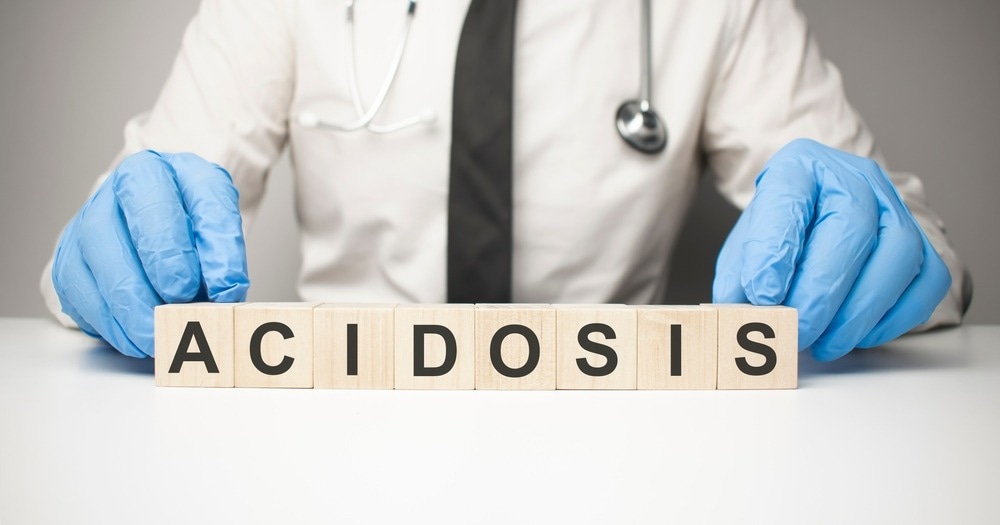A group of scientists from China has recently developed an antacid nanoantidote that can effectively ameliorate blood acidosis induced by severe acute respiratory syndrome coronavirus 2 (SARS-CoV-2) infection. The study has been published in the journal VIEW.

Background
Coronavirus disease 2019 (COVID-19) caused by SARS-CoV-2 is known to induce respiratory and metabolic acidosis, especially diabetic ketoacidosis. In critically ill COVID-19 patients, acidosis (reduced blood pH) has been found to increase the risk of mortality.
Intravenous administration of sodium bicarbonate is considered to be the standard treatment for acidosis. However, the treatment comes with many disadvantages, including sodium overload, hypokalemia, and hypocalcemia. This highlights the need for developing new therapeutic interventions with minimal side effects.
In the current study, the scientists have investigated whether SARS-CoV-2 infection-induced acidosis further promotes SARS-CoV-2 infection via a positive feedback loop. In addition, they have developed an antacid nanoantidote and assessed its efficacy in mitigating COVID-19-related acidosis.
Impact of acidosis on SARS-CoV-2 infection
Acidosis is characterized by increased acid content (increased hydrogen ion concentration) in the blood or other tissues. The condition is associated with a reduction in blood pH from its normal value of 7.35 – 7.45.
The impact of COVID-19-related acidosis on SARS-CoV-2 infection efficiency was investigated by culturing angiotensin-converting enzyme 2 (ACE2)-expressing human cells in different pH conditions in the presence of SARS-CoV-2. The pH values of 6.8, 7.4, and 7.8 were considered for the experiments as acidic, normal, and alkaline conditions, respectively.
The findings revealed that COVID-19-related acidosis (pH 6.8) increases the efficiency of SARS-CoV-2 to infect cells compared to normal blood pH (7.4). In contrast, the alkaline pH (7.8) reduced the viral efficacy of infecting cells.
These observations highlight the existence of a positive feedback loop wherein SARS-CoV-2-induced acidosis further facilitates viral propagation in human cells.
Development of antacid nanoantidote
The antacid antidote was constructed by initially synthesizing functional block copolymers (polyglutamic acid-PEG), followed by interactions of copolymers with calcium ions and carboxyl groups to form calcium carbonate nanoparticles (nanoantidote).
Regarding mode of action, the nanoparticles gradually increased the pH from 6.8 to 7.4 in a dose-dependent manner. In other words, the nanoparticles neutralized hydrogen ions in the solution to restore normal pH.
Functional characterization of nanoantidote
The nanoantidote developed in the study showed high efficacy in preventing acidosis (pH 6.8)-mediated induction in SARS-CoV-2 infection efficacy.
The analysis revealed that an acidic pH helps increase infection efficiency by increasing the expression of ACE2 on the cell membrane. In contrast, the treatment with nanoantidote caused a reduction in ACE2 expression, which is probably the mechanism of nanoantidote-mediated attenuation of viral infection in acidic pH.
It is known that ACE2 colocalize with actin, and the actin filament-bundling protein Fascin-1 regulates the expression and cellular localization of ACE2.
The morphological analysis of actin conducted in the study revealed that the actin polymerization remains stable at both normal and alkaline pH. In contrast, the acidic pH induced a fuzzy dispersion actin morphology in the cells.
The treatment of cells with nanoantidote revealed that the nanoparticles can restore actin polymerization and stabilization by increasing acidic pH to the normal level. This might be a possible mechanism of nanoantidote in mitigating viral infection efficacy.
Further validation of the nanoantidote mode of action was done by using an actin polymerization and stabilization inducer. The inducer was found to reduce ACE2 expression on the cell membrane as well as viral infection efficiency in the acidic pH.
Overall, these observations indicate that acidic pH promotes SARS-CoV-2 infection by reducing actin polymerization, which is associated with higher ACE2 expression on the cell membrane.
Study significance
The study describes the development and validation of calcium carbonate nanoparticles that can be used as a nanoantidote to neutralize acidic pH and reduce SARS-CoV-2 infection efficiency.
The nanoantidote reduces cell surface expression of ACE2 probably by increasing actin polymerization and stabilization in acidic pH. Based on these findings, the scientists suggest that the nanoantidote could be used as a safer alternative to sodium bicarbonate in treating acidosis in critically ill COVID-19 patients.
- Liu Q. 2022. Nanoantidote for repression of acidosis pH promoting COVID-19 infection. VIEW. doi: https://doi.org/10.1002/VIW.20220004 https://onlinelibrary.wiley.com/doi/10.1002/VIW.20220004
Posted in: Medical Science News | Medical Research News | Disease/Infection News
Tags: ACE2, Actin, Angiotensin, Angiotensin-Converting Enzyme 2, Antidote, Blood, Calcium, Calcium Carbonate, Cell, Cell Membrane, Coronavirus, Coronavirus Disease COVID-19, covid-19, Diabetic Ketoacidosis, Efficacy, Enzyme, Hypocalcemia, Hypokalemia, Ion, Membrane, Morphology, Mortality, Nanoparticles, pH, Propagation, Protein, Respiratory, SARS, SARS-CoV-2, Severe Acute Respiratory, Severe Acute Respiratory Syndrome, Sodium Bicarbonate, Syndrome

Written by
Dr. Sanchari Sinha Dutta
Dr. Sanchari Sinha Dutta is a science communicator who believes in spreading the power of science in every corner of the world. She has a Bachelor of Science (B.Sc.) degree and a Master's of Science (M.Sc.) in biology and human physiology. Following her Master's degree, Sanchari went on to study a Ph.D. in human physiology. She has authored more than 10 original research articles, all of which have been published in world renowned international journals.
Source: Read Full Article
